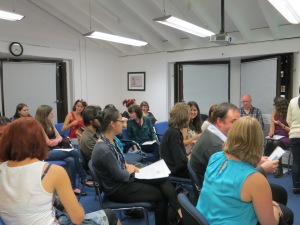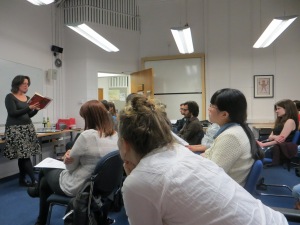Anikó Szilágyi is a third-year PhD student in Translation Studies at the University of Glasgow. She spent two weeks this summer at the Hungarian Translators’ House in Balatonfüred, Hungary, working on her translation of a 1967 Hungarian novel titled Győzelmes Gábriel [Gabriel the Victorious] by György Méhes. She recounts her experience below.


I have many fond memories of visiting Lake Balaton in Western Hungary as a child. It was, and still is, the place to go if you wanted to get away from the bustle of metropolitan Budapest and enjoy the sun, the water, and – if you are old enough – the excellent Balaton wines. The region grew into a major tourist destination in the late 19th century, and today it attracts large numbers of domestic tourists as well as visitors from surrounding countries every summer. But this year I had a different reason for visiting this beautiful part of the Hungarian countryside: I went not as a tourist but as a translator.
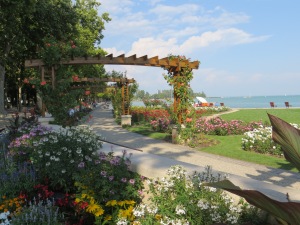
Balatonfüred is one of the most popular resort towns on the northern shore of Lake Balaton. It became a centre for literary and cultural activity in the 1800s with writers, politicians and other prominent public figures as regular visitors looking to relax, socialise, or work. Mór Jókai, the great nineteenth-century novelist, wrote his masterpiece The Man with the Golden Touch [Az arany ember] in his summer house in Balatonfüred, which was translated into English and published by Corvina Press in 1963. Starting in the 1940s, the home of cultural historian Gábor Lipták served as a literary salon for almost four decades. Lipták’s will stated that the house must become an artists’ residence after his death. The building was renovated in the 1990s, and on 21 January 1998 the first translators’ house in Central and Eastern Europe opened its doors.
The Hungarian Translator’s House is operated by a Budapest-based foundation of the same name. It hosts translators from any linguistic and national background who translate out of Hungarian, offering 2-8-week residencies and stipends to cover living costs and contribute towards travel expenses. Applications are open all year round, and applicants have to submit a proposal, a publications list and, where possible, a contract or expression of interest from a publisher. When I applied in March 2015, I was sceptical about my chances of securing a place: translating into one’s second language is often frowned upon in literary circles. I was pleasantly surprised when (after waiting for a few weeks, then sending a reminder) I got a short reply: “Your application has been accepted. When would you like to come?”
When I stepped off the train in Balatonfüred three and a half months later, I still wasn’t sure what to expect. Not having to worry about money was reassuring: Glasgow University had generously funded my flights between Glasgow and Budapest, and I knew the stipend from the House would cover all necessary expenses during my stay. I had never been offered a residency before, so it was hard for me imagine how I would live for the next two weeks. I decided to walk to the House from the train station with a badly printed Google map in hand, and, naturally, got lost. Getting to the House was a relief.


I was received by the summer intern, Ági, who showed me around the gorgeous Lipták Residence. I immediately felt at home. The house was well-maintained and yet retained an old feel both inside and out, and it was full of beautiful antique furniture, original artworks, and, of course, books. There was an inlaid dining table in the middle of the entrance hall which, I later learned, dated from 1563 and had ended up in the House by accident, thanks to some Soviet soldiers who had allegedly traded it for wine. The shared facilities included a well-equipped kitchen and dining room, a library on the upper floor, and a sizeable garden. All six rooms were either en-suite or came with a separate bathroom and toilet.
My room was small but lovely. A fig tree right outside my window provided some shade as well as privacy (and I tasted a fresh fig for the first time in my life). I had my own PC, which I didn’t use because I preferred my own laptop, a huge desk, and a smaller table perfect for keeping dictionaries to hand. There were a few shops within walking distance, so I went food shopping every day, more for the exercise than for the food itself. I spent most of my time in my room working on the translation, but there were also opportunities to socialise with other residents and build professional relationships and friendships.

I was initially aiming to finish the book during my residency, which would have meant translating about 50,000 words in fourteen days. Given that most non-literary translators get through a maximum of 2000 words per day, and that literature takes a lot longer, this was optimistic, to say the least. I quickly realised my plan was far too ambitious, but it was fine: I comforted myself with the thought that quality took precedence over quantity, and aimed to make good use of House’s resources instead of trying to get through as much translation material as was possible. The various monolingual Hungarian dictionaries held in the House’s collection came in handy, because these are not accessible online. I also rediscovered the standard bilingual dictionaries I had been using before I moved to Scotland.

I never doubted the benefits of the peace and quiet the Translators’ House could offer, but I was curious about whether and how these would affect the quality of my translation. Quality is, of course, notoriously hard to measure, but having now proofread the six chapters I completed at the House, I can see a change in the quality of my target text that is unlikely to be attributable solely to the unevenness of the source text. In other words, I think I was translating much better by the end of my residency than at the start of it, and this, I suspect, has more to do with the mindset I was able to get into than the source text becoming objectively easier to translate.


It was a bittersweet moment when the two weeks were up. I was pleased with my work and excited about going on holiday with my family, but I also felt like staying because I had more work to do and more translation questions to discuss with my colleagues and friends. I ended up producing about half as much text as I had hoped, but of much better quality, and I even unexpectedly bumped into a prominent English translator of Hungarian fiction, Bernard Adams. I interviewed him over coffee and cake, and we remain in regular email contact, which is essential in a small field like ours. I haven’t yet found out if I could come back to the Translators’ House next year to continue the same translation, but I will certainly try. I will be a few months from submitting and in sore need of breathing space and professional support, and I can’t think of a better place that provides them both.
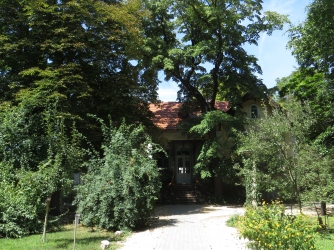


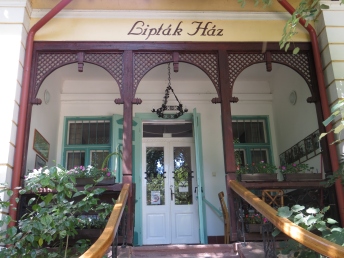










![Joe McGhee reads from If This Is A Man [Se questo è un uomo] by Primo Levi.](https://translationstudiesatglasgow.files.wordpress.com/2014/10/img_4788.jpg?w=300&h=225)


![Monika Nowicka reads from The Name of the Rose [Il nome della rosa] by Umberto Eco](https://translationstudiesatglasgow.files.wordpress.com/2014/10/img_4778.jpg?w=225&h=300)
